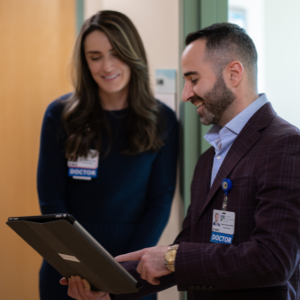News & Articles
Read the latest news, press releases, and information about providers, technological advances, services and programs at Southern New Hampshire Health.

Read the latest news, press releases, and information about providers, technological advances, services and programs at Southern New Hampshire Health.
Access photos and obtain facts and figures about Southern New Hampshire Health.
View Resources
Southern New Hampshire Health continues to earn accreditations, accolades, and awards.
View Our Awards
Our expert providers offer important health-related information on a variety of topics.
Listen Here

Southern New Hampshire Health Welcomes Dr. Ciara Kazakis to Downtown Medical Associates and Christian Niles, PA-C to Foundation Orthopedics
December 18, 2025
Southern New Hampshire Health welcomes two new providers to the health system, Dr. Ciara Kazakis and Christian Niles, PA-C. Both of these Their expertise, dedication, and commitment to patient-centered care will...

Governor Kelly Ayotte Visits Southern New Hampshire Health to Discuss Future of Healthcare Across the Region
December 18, 2025
Governor Kelly Ayotte visited Southern New Hampshire Health for a roundtable discussion and tour focused on innovation, workforce growth, and expanding access to high-quality healthcare across the...

Now is Not the Time to Retreat from Vaccines
December 11, 2025
As a physician who has cared for thousands of patients across New Hampshire for more than three decades, and now serves as a chief medical officer, I write today because protecting our community has never mattered...

Southern NH Health Promotes Rebecca Cooper-Piela to Senior Vice President and Chief Quality Officer
December 9, 2025
Southern New Hampshire Health has promoted Rebecca Cooper-Piela, MS, APRN-BC, CHCQM, to Senior Vice President and Chief Quality Officer, overseeing quality, accreditation, regulatory, and population health...

Top 3 Winter Foot Care Tips from the Experts at Foundation Foot & Ankle Medicine/Surgery
December 2, 2025
Cold weather can be tough on your feet. Learn expert tips to prevent cracked heels, choose proper winter shoes, and boost circulation from Foundation Foot & Ankle Medicine/Surgery of Southern NH...

Snoring Isn’t Just Annoying: It Could Be Your Body’s Cry for Help
December 2, 2025
Think snoring is harmless? It may be a warning sign of sleep apnea—a serious condition linked to fatigue, heart disease, and stroke. Learn symptoms, risks, and treatment options from Amherst Family...

Holiday Eating Made Easier: 6 Tips for Staying on Track
November 24, 2025
Learn simple, effective strategies to stay healthy during the holiday season without depriving yourself. Dr. Robert Catania from Southern New Hampshire Weight Management shares practical tips on portion control,...

The Power of Knowing: Genetic Counseling and Cancer Prevention
November 19, 2025
Learn how genetic counseling at Southern New Hampshire Health helps patients understand inherited cancer risk, guide screening, and make informed health...

Southern NH Health Welcomes Three New Providers
November 19, 2025
Southern NH Health is proud to welcome three new providers to the system. Dr. Le, Rachel Demers, CNM, and Katelyn Tavares, APRN bring years of experience and are dedicated to providing the level of care our...

Southern NH Health Names Dr. Andrew Watt as Chief Clinical Integration and Transformation Officer
November 13, 2025
Southern New Hampshire Health announces the return of Dr. Andrew Watt as Chief Clinical Integration and Transformation Officer to the organization. In this role, Dr. Watt will lead strategic initiatives to...